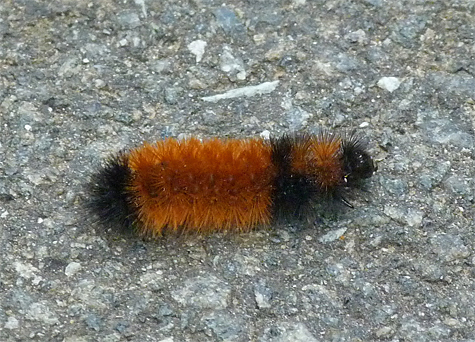According to folklore, the caterpillar below foretells a mild winter this year, the wider the reddish band the milder the winter.

The reddish band on the caterpillar is actually an indication of its age. Each successive molt of the caterpillar adds more reddish hairs, or setae, lessening the number of black setae. The caterpillar may molt 5 or 6 times. Each stage between molts is called an instar. The last instar has the most reddish setae.
Woolly Bears overwinter as caterpillars in the leaf liter, pupating the following spring. If it happens to be a mild fall you’re likely to see more reddish caterpillars since more of them will be out and about for a longer period of time, allowing them to perhaps molt into their final instar (last molt before pupating). With the most possible reddish hairs, in this final stage before pupating, the caterpillar would appear to be predicting a mild winter.
With the early onset of cold weather in fall the caterpillars may be forced into early hibernation, going through fewer molts and therefore wearing fewer reddish setae. You would see fewer reddish caterpillars, suggesting a cold winter.
Further, there is individual variation in the width of the reddish bands on hatchlings from the same batch of eggs. In other words, some caterpillars may have wider red bands bands then their siblings from the begining, when they first hatch.
Whatever the reason for the width of the bands on these caterpillars, I’d like to believe that what the Woolly Bear in the photo is predicting comes true, a mild winter. But I’ll take whatever the winter brings with it. After all, how bad can the winter get here in Durham, North Carolina.
Reminds me of our Red Ruffed lemurs